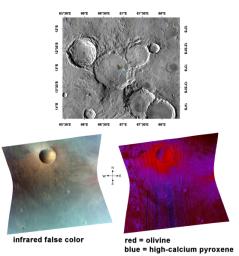
|
An Olivine-Rich Crater in Tyrrhena Terra
- Click the image above for a larger view
- Full-Res JPEG (1576 x 1688) (282.7 kB)
- Full-Res TIFF (1576 x 1688) (8.0 MB)
Caption:
This image of the ejecta of a crater in the Tyrrhena Terra region was taken by the Compact Reconnaissance Imaging Spectrometer for Mars (CRISM) at 0328 UTC on February 23, 2007 (10:28 p.m. EST on February 22, 2007), near 13 degrees south latitude, 67 degrees east longitude. CRISM's image was taken in 544 colors covering 0.36-3.92 micrometers, and shows features as small as 18 meters (60 feet) across. The region covered is roughly 9 kilometers (5.6 miles) wide at its narrowest point.
Named for a classic albedo feature, Tyrrhena Terra is an extensive, heavily-cratered part of Mars' southern highlands, some 2,300 kilometers (1,430 miles) at its broadest extent. It is located to the northeast of the Hellas basin. The region imaged by CRISM is to the north of Hellas Planitia and just east of the crater Huygens in Tyrrhena Terra's western end.
The uppermost image in the montage above reveals the location of the CRISM image on a mosaic taken by the Mars Odyssey spacecraft's Thermal Emission Imaging System (THEMIS). The CRISM image is located inside a large, flat-floored crater measuring about 52 kilometers (32 miles) across. The image includes a small crater and its ejecta blanket, an apron of material thrown out during a crater's formation, both located inside the larger crater.
The lower left image is an infrared false-color image that reveals the extent of the ejecta blanket. It also includes ejecta from another small crater located just east of the CRISM image.
The lower right image shows the strengths of mineral absorptions, and reveals the composition of the ejecta and surrounding material. The ejecta surrounding the small impact crater is thickest at the crater's rim, and becomes thinner to discontinuous at the blanket's outer edge. This small crater's ejecta blanket shows an enhanced spectral signature of the mineral olivine, as does the ejecta from the small crater just out of view to the east. In contrast the surrounding material is rich in the volcanic mineral pyroxene. This relationship demonstrates the layered characteristic of rocks forming the southern highlands: olivine-rich rock was buried by pyroxene-rich materials on the larger crater's floor, probably volcanic lavas. Later, the small crater penetrated the pyroxene-rich rock, excavated the underlying olivine-bearing unit, and deposited it as ejecta.
Background Info:
CRISM is one of six science instruments on NASA's Mars Reconnaissance Orbiter. Led by The Johns Hopkins University Applied Physics Laboratory, Laurel, Md., the CRISM team includes expertise from universities, government agencies and small businesses in the United States and abroad. NASA's Jet Propulsion Laboratory, a division of the California Institute of Technology in Pasadena, manages the Mars Reconnaissance Orbiter and the Mars Science Laboratory for NASA's Science Mission Directorate, Washington. Lockheed Martin Space Systems, Denver, built the orbiter.
Cataloging Keywords:
| Name | Value | Additional Values |
|---|---|---|
| Target | Mars | |
| System | ||
| Target Type | Planet | |
| Mission | Mars Reconnaissance Orbiter (MRO) | 2001 Mars Odyssey, Mars Science Laboratory (MSL) |
| Instrument Host | Mars Reconnaissance Orbiter | Curiosity Rover, Mars Odyssey |
| Host Type | Orbiter | Rover |
| Instrument | Compact Reconnaissance Imaging Spectrometer for Mars (CRISM) | |
| Detector | ||
| Extra Keywords | Color, Crater, Impact, Infrared, Thermal, Volcano | |
| Acquisition Date | ||
| Release Date | 2008-05-20 | |
| Date in Caption | 2007-02-22 | 2007-02-23 |
| Image Credit | NASA/JPL/JHUAPL/ASU | |
| Source | photojournal.jpl.nasa.gov/catalog/PIA10945 | |
| Identifier | PIA10945 | |
